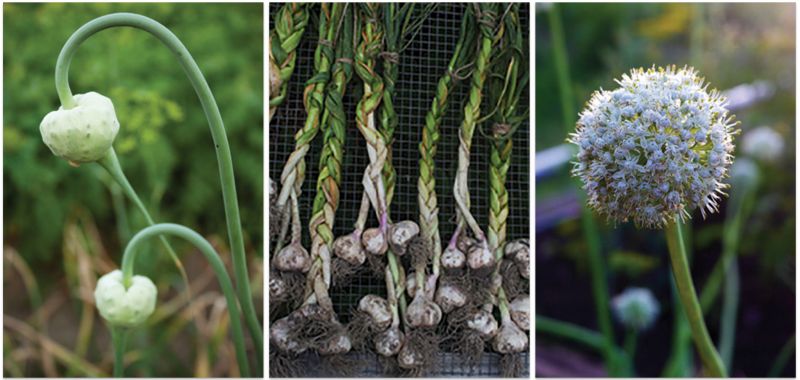Tips on growing, harvesting, and storing the savory bulbs

(Left to right) Hardneck garlic produces scapes that form attractive seed heads; braided softneck garlic cures on a screen; seed heads open into charming blooms.
It just so happens that when vampires appear—stalking store shelves and front yards alongside fellow Halloween haunts—it’s time to plant garlic (Allium sativum). The bulbs need months of cool darkness before they can send shoots above ground in spring. Considering how easy it is to grow a variety of tasty—and sometimes beautiful—garlics, the advance planning is well worth your while.
Know Your Types
There are two basic types of garlic. If you want cloves for the kitchen, softneck varieties are your best bet. They’re well-suited to the Lowcountry climate and great for braiding.
Hardneck varieties weather our mild winters less reliably, but they have something softnecks don’t: scapes. In April, these bright-green shoots appear, curling into seed heads pretty enough for the perennial garden.
You can clip off scapes for cooking; doing so allows the bulbs to grow larger, which is beneficial if you plan to harvest them. Or let the scapes form flowers. “They’re beautiful—smaller versions of the alliums everyone wishes we could grow here,” says Charleston garden editor Joan McDonald, who dries the blooms for floral displays. Bulbs lose their flavor after flowering, so leave these plants in the ground and they’ll likely return as perennials.
Growing Basics
Garlic grows best in full sun in well-drained, fertile soil—whether in the ground, a raised bed, or a pot. Break cloves off a “seed bulb” and bury them about an inch deep, with the pointy end up. The larger cloves on the outside of the bulb will yield bigger plants.
Top the soil with four to six inches of mulch. Keep the ground consistently moist until the plants are nearly mature, then cut back on watering. When the leaves begin to turn yellow in early summer, it’s time to harvest.
Harvesting & Storing
Pull the entire plant from the ground with your hand, or lift it with a spading fork, and brush the soil off.
The bulbs need to cure for two to three weeks in a warm, shady place with good air circulation (perhaps a shed, garage, or room indoors). Hang them in bundles, or spread them out on screens or racks until the necks are dry and the outer skin is papery.
For storage, braid the stalks of softneck varieties, gather bulbs in a mesh bag, or tie heads together for hanging. Generally, garlic will keep for six to eight months in a well-ventilated, cool, dry location. Digging into a fragrant stash of homegrown cloves, you’ll thank yourself for the autumn planting effort.
At a Glance: Garlic
- Plant: October 1-November 30, about five inches apart
- Soil: Well-drained, fertile loam with a pH of 6.2 to 6.5
- Sunlight: Six or more hours a day
- Water: Maintain consistent moisture
- Buy Bulbs: Shop local at Hyams and Roots and Shoots. Online, check out Filaree Garlic Farm at filareefarm.com.
Get chef John Ondo’s tips on cooking with garlic as well as a couple of recipes here.